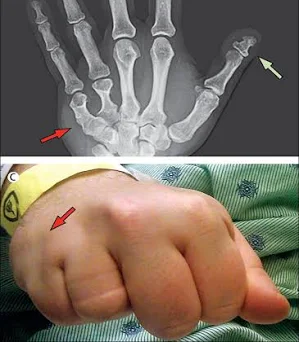 Pseudopseudohypoparathyroidism (PPHP) is a rare Genetic Disorder characterized by the physical features of Pseudohypoparathyroidism (PHP) but without the associated Hormone Resistance. In PPHP, the body's response to Parathyroid Hormone (PTH) is normal, and PTH levels are within the normal range. This contrasts with PHP, where there is resistance to PTH, leading to high PTH levels and low Calcium. It also differs from true Hypoparathyroidism, which is characterized by insufficient production of PTH, resulting in low PTH and low calcium.
Pseudopseudohypoparathyroidism (PPHP) is a rare Genetic Disorder characterized by the physical features of Pseudohypoparathyroidism (PHP) but without the associated Hormone Resistance. In PPHP, the body's response to Parathyroid Hormone (PTH) is normal, and PTH levels are within the normal range. This contrasts with PHP, where there is resistance to PTH, leading to high PTH levels and low Calcium. It also differs from true Hypoparathyroidism, which is characterized by insufficient production of PTH, resulting in low PTH and low calcium.
Individuals with PPHP exhibit the physical characteristics of Albright's Hereditary Osteodystrophy (AHO), which include short stature, a round face, obesity, and particularly Brachydactyly (shortened fingers and toes). Despite these notable skeletal and developmental features, their Calcium and Phosphate levels remain normal, and they do not experience the Hormone Resistance seen in Pseudohypoparathyroidism.
PPHP arises from a genetic mutation, specifically involving the GNAS Gene (Guanine Nucleotide-binding protein, Alpha Stimulatory activity polypeptide) on Chromosome 20. This gene is critical for the function of G-proteins, which are involved in many cellular signaling pathways, including those regulated by Parathyroid Hormone. Unlike typical Pseudohypoparathyroidism (e.g., PHP1A), which results from maternal inheritance of a GNAS mutation, PPHP typically stems from the paternal inheritance of a GNAS mutation. This difference in parental origin, known as Genomic Imprinting, explains the distinct clinical presentation: individuals with maternally inherited mutations often develop PHP (with hormone resistance), while those with paternally inherited mutations develop PPHP (physical features without hormone resistance).
The manifestation of Albright's Hereditary Osteodystrophy (AHO) in PPHP is primarily characterized by skeletal abnormalities. Besides short stature and obesity, common features include a rounded face, dental abnormalities, and distinctive Brachydactyly, often described as shortening of the 4th and 5th Metacarpals and Metatarsals, leading to 'dimples' over the knuckles when a fist is made. Subcutaneous Ossifications (bony deposits under the skin) may also be present, particularly in older individuals. Developmental delays or mild Cognitive Impairment can occur in some cases, although these are not universal features and the severity varies widely.
Diagnosis of PPHP is typically based on the presence of the characteristic clinical features of Albright's Hereditary Osteodystrophy combined with normal serum Calcium, Phosphate, and Parathyroid Hormone levels. Genetic Testing for mutations in the GNAS Gene and analysis of parental origin can confirm the diagnosis and distinguish it from other related disorders. Since PPHP does not involve Hormone Resistance or significant metabolic imbalances, treatment is generally symptomatic and supportive, focusing on managing the physical manifestations of AHO and addressing any developmental concerns. Regular monitoring for potential complications is usually not required unless specific symptoms arise.